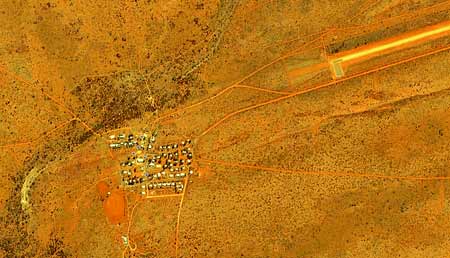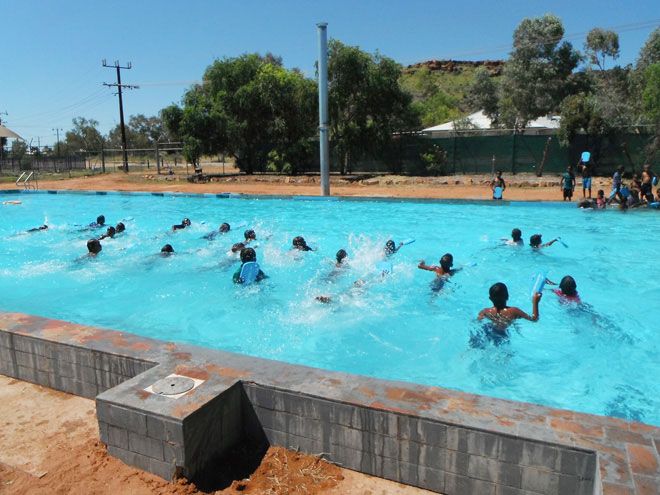Victory for the tiny desert community that sparked NT-wide reform
10 April 2012
 By KIERAN FINNANE
By KIERAN FINNANE
The Territory local government elections, with their new counting system, have delivered for the tiny community of Nyirripi in the Southern Tanami Ward of Central Desert Shire. Nyirripi now have seat on the council with their local representative, Jacob Spencer. This is a big win for the community as it was from there that the drive for reform of the counting system came.
In 2008 Nyirripi’s candidate, Teddy Gibson Jakamarra, won the highest number of first preference votes of any candidate in the ward but failed to get a seat on council. When the community’s Local Board realised that the cards were stacked against them because of the exhaustive preferential counting system, they asked the shire to lobby the NT Government about it. The shire councillors listened to a  presentation by Dr Will Sanders (ANU and Desert Knowledge CRC, pictured), who showed how the old system favoured large group dominance. Armed with this evidence the shire wrote to Local Government Minister Malarndirri McCarthy requesting the review which ultimately led to Territory-wide reform for the local government electoral system.
presentation by Dr Will Sanders (ANU and Desert Knowledge CRC, pictured), who showed how the old system favoured large group dominance. Armed with this evidence the shire wrote to Local Government Minister Malarndirri McCarthy requesting the review which ultimately led to Territory-wide reform for the local government electoral system.
The reform also had a definite impact in Alice Springs, says Dr Sanders, reflected in the early election of candidates at either end of the political spectrum: on the ‘right’, Steve Brown, Eli Melky, Dave Douglas in positions one, two and three, and then on the ‘left’, the Greens’ Jade Kudrenko in position four.
The old system would have favoured the ‘centre’ candidates earlier. Apart from being well-respected they also had incumbency in their favour, but Liz Martin was not elected till the fifth position, with Brendan Heenan following at seventh behind youthful newcomer Chansey Paech.
Mayor Damien Ryan has done well out of the election, comments Dr Sanders. There was “significant leakage” from his rivals despite them all placing him last on their how-to-vote cards.
“He picked up around a quarter of preferences at each exclusion: 135/489 from Bitar, 397/ 1217 and 32/132 from Douglas, and 610/ 1972 from Melky. So at that rate of leakage he ended up being pretty safe with 43.6% of the primary vote.”
He now heads a council with two possible voting blocks which, with his vote, can become a majority. The challenge will be for him – and for the centre to left councillors – to take the initiative in setting the agenda, rather than be simply reacting to or managing the agenda set by the energetic right, as well as the administration.
Overall, Dr Sanders describes the Alice election as “fabulous” for the real interest taken in it by the community and by candidates of very different opinions and approaches wanting to stand up and be counted.
The shires, however, continue to struggle to have this sense of local relevance and connectedness. The number of uncontested and failed or partly failed elections in the shires (leading to supplementary elections having to be called) has gone up since 2008, says Dr Sanders. In Alice’s neighbouring shires, Central Desert and MacDonnell, only two of the wards, one in each shire, had elections where there were more candidates than vacancies. There will be supplementary elections for one ward in each shire where there were fewer candidates than vacancies, with nominations closing on April 24.
In the remaining two wards of each shire the number of candidates equalled the number of vacancies and so they were returned unopposed. This possibly reflects “processes of community discussion throwing up ‘just the right number’ of nominations for positions available”, says Dr Sanders.
“This was common in the ‘little, remote-area local governments’ prior to 2008 and is still common in the ‘remaining little local governments’ on the outskirts of Darwin due to the abandonment of the proposed Top End Shire in early 2008. Eight out of 10 wards in Coomalie and Litchfield had ‘just the right number’ of nominations for available councillor positions in 2012.”
It is also possible, however, that the uncontested wards reflect a loss of interest in the shires. The initial poor electoral system may have contributed to this but there are obviously other challenges, says Dr Sanders.
It is interesting to note, for example, that the old electoral system favoured dominance of Yuendumu in the Southern Tanami Ward, but all four of their representatives failed to see out the first term.
It is also sad to note the decline of interest in representation from the Anmatjere Ward. In 2008 nine candidates contested the four vacancies. Among the successful four was James Jampajimpa Glenn, the youngest councillor in the shire, who was then elected as the first shire president. In 2012 only one candidate came forward, the incumbent Adrian Dixon from Laramba, and he was duly returned unopposed.
Loss of interest?
Prior to 2008 the Anmatjere Community Government Council, representing the open town of Ti Tree on the Stuart Highway as well as a number of Aboriginal (Anmatjere-speaking) communities, was one of the more effective. Dr Sanders spent a lot of time observing its operations between 2004 and 2008.
He has described it as “a small regional local government that was big enough to achieve organisational continuity and was both useful to and valued by its 1,000 or so constituents”.
He observed “the building of a managerial team of about half a dozen and some increase in the range of services provided by the organisation” as well as “two orderly transitions of Chief Executive Officer and of Council chair”. He said councillors took seriously representation of their wards as well as the region.
Then came the super-shire changes, with the Anmatjere Council rolled into the Central Desert Shire along with five other local governments, across a huge swathe of land stretching north of Alice from WA to Queensland.
In many ways Ti Tree would have been the logical choice for the shire head office but the choice to position it in Alice Springs 100 kilometres south of the shire’s southern boundary “seemed in many ways to set the pattern for much that was to come ” – which has been essentially to head towards “becoming a well governed, urban-based organisation that is of rather limited daily relevance to its remote area constituents”.
“This is not an organisation which the remote area localities and constituents created for themselves, or over which they feel great influence. They can accept the services the Shire offers or look for alternatives. But any attempt to influence the Shire through representation will come up against its vast geographic scale, its distant central administration, and also [until the recent reform] an inadequate electoral system.”
Central Desert is not alone in this: “Seven of the eight shires now have major offices outside their boundaries in the Territory’s major urban centres of Darwin, Alice Springs and Katherine. For most constituents, these are no longer accessible local governments whose headquarters are just down the road, or even an hour or two’s drive away. They are distant, urban-based organisations experienced by locals as somewhat alien and bureaucratic, like higher levels of government.”
Dr Sanders does not deny the problems of the past small remote area councils: “Regional up-scaling was in many ways a legitimate objective” but the system has swung from “possibly a bit small” to “definitely too big”.
It will be interesting to observe how all this plays out, in the immediate term with the supplementary elections and over the next five years . The Country Liberals have mooted changes but without much clarity about how they would “at least cost satisfy the need for financial accountability and the enhanced provision of services through greater local empowerment” [their emphasis].
The first meetings of the 2nd Central Desert and MacDonnell Shire Councils take place this week, while the 12th Alice Springs Town Council kicks off next Monday.
Pictured below: Shire business rolls on. The pool at Santa Teresa reopened just in time for the end of summer, following extensive repairs undertaken by MacDonnell Shire and funded by the NT Department of Sport and Recreation, CentreCorp Foundation, and LGANT, with YMCA Central Australia and Swimming Australia offering on the ground support. The shire organised this Pool Party for the weekend of March 31 to April 1 and the pool has been open again over the Easter school holidays. The existing children’s pool is “unsalvageable” but the shire has applied for funds to replace it. Photo courtesy MacDonnell Shire.




Apparently Dr Sanders has forgotten the very basis of this nation’s democracy! Democracy came into being after thousands of years of domination, brutality, infighting and bloodshed. It is the best system devised to date that gives the general population a lot of freedoms including that of free speech and still manages to keep them from each others throats.
Democracy achieves its goals by everyone within the system recognising, respecting and accepting at least until such time as they can change their minds by good argument, the view and wishes of the majority.
Mr Sanders method is a blatant, openly stated attempt to bypass the wishes of the majority in a rather paternal attempt to interfere in the election process as he sees it affecting communities. Mr Sanders has worked on the old system of sloth and mediocrity seeing it as easier to take everyone down to the lowest common denominator than to lift all to the highest.
If this system was operating anywhere other than under the Territory Government’s deliberately and pathetically watered down Local Government Act, if it were ever attempted at Territory or Federal level it would be thrown out by the High Court as simply undemocratic, a system of election that negates the will of the majority and is more akin to drawing numbers out of a barrel lottery style!
Let’s not forget that every Council in the Territory rejected this system! Yet the NT Government still brought it into being! Another bit of arrogant, patronising, paternal crap to their endless list of failures. Play with our Democracy at your own peril NT Government! Roll on August!
[ED – This counting system, known as Single Transferable Vote Proportional Representation, is the one in place for counting votes in the Australian Senate elections. It is also in place for Upper House elections in all Australian states bar Tasmania. A version of it (the Hare-Clark system) is used for Lower House elections in Tasmania and the ACT. It is also in use overseas, for instance in the Republic of Ireland where it is the system for parliamentary, European and local government elections. It is used for local government elections in Scotland, for some local government elections in New Zealand, for some city elections in the USA. This list is not comprehensive.
Clearly not every council in the NT opposed it, as the Central Desert Shire Council led the push for change. However, the municipal councils in the NT did not want it.]
I admit to being in favour of the new voting system and was relieved when it was decided to use it in all NT local elections.
But as a matter of interest, is there a number cruncher among this site’s readers who could run the votes cast in our recent municipal election through the old exhaustive preferential system. It might be interesting to see if there would be any differences in whom we elected.
Just an idea. I have no idea if this exercise is even possible.
Re Steve Brown (Posted April 11, 2012 at 4:31 pm):
I would like to nominate this comment by Steve as the rudest, most arrogant, pompous and ignorant of the current calendar year so far. It’s going to be an even more interesting four years than I had previously imagined.
Steve @3 It is clear that you do not understand the voting system and the democratic principles on which it is based. Perhaps you should do some more research and if, having done that, you still think it undemocratic come back and tell us why.
@3 In response to Hal Duell, there’s no technical reason why the votes cast in the recent council elections cannot be distributed using the former exhaustive preferential system; however, it would best be done using the computer program that the NT Electoral Commission used to determine previous election results (this would save an immense amount of time). It would be interesting to compare the results of the recent Alice town council election using the two systems of counting.
I also remind readers I undertook this exercise with regard to the NT election results of 2005. On that occasion the ALP stormed to victory winning 19 seats out of 25; the CLP was crushed, winning only four seats, and independents took the remaining two. However, there was a major discrepancy when comparing the overall voting results as a percentage across the NT – Labor had won only 51.94 per cent of the total first preference votes, the CLP had attracted 35.73 per cent, and the independents 8.04 per cent (the remainder went to The Greens and others).
I calculated what the make-up of the NT Legislative Assembly would look like under a proportional voting system, assuming there were five electorates each of five members, and utilizing the votes of the 2005 elections. The result came out with Labor winning 13 seats, the CLP took 11 seats, and there was one independent (see my article “Beating Berrimah Line at ballot box”, Alice Springs News, 12 June 2008).
Astonishingly, my article preempted exactly the results that emerged in the 2008 NT elections just two months later – Labor with 13, CLP 11, and one independent – and that occurred with the current preferential voting system for single-member electorates.
It will be interesting to see what surprises are in store for us in this year’s NT elections!